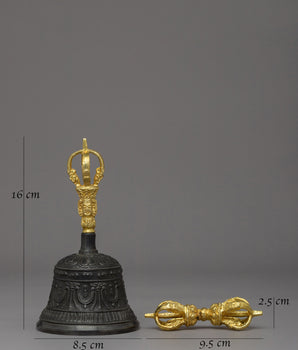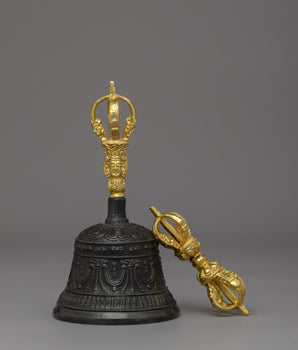Life Of Milarepa: The Inspiring Journey from Revenge to Enlightenment
The Life of Milarepa is a fantastic tale that has motivated numerous people for centuries. As a Buddhist poet and yogi, he flourished in Tibet in the 11th century. He is well-known for his poetry, spiritual teachings, and inspiring life story.
Tibetan Buddhism recognizes Jetsun Milarepa's spiritual journey and teachings as a profound and inspirational. He is admired for his deep insight and the clarity of his teachings, emphasizing the importance of mindfulness, meditation, and compassion. He wrote songs and poetry throughout his lifetime, still studied and revered in Tibet and elsewhere.
Early Life and Sorcery Of Milarepa Click here to view our High-Quality Jetsun Milarepa Statues
Click here to view our High-Quality Jetsun Milarepa Statues
Milarepa was born into a wealthy family, but after his father passed away, his uncle took control of the family's assets, and Milarepa's life took a fatal turn. He used black magic and supernatural abilities to trigger a landslide that killed many people, including his uncle's family, to exact revenge. Soon after realizing his mistake, he devoted his life to meditation and spiritual activities to purify his karma.
Jetsun Milarepa and Guru Marpa
Milarepa couldn't come to terms with the evil he had committed. He disowned his actions and resolved to spend the rest of his life pursuing a spiritual path. He studied Buddhism, but no teacher could absolve him of guilt and a troubled conscience until he encountered Marpa. Recently returned from India, Marpa was a translator who had been studying and was married - a lay Buddhist. Milarepa placed himself under the guidance of this guru, also known as the "root mentor."
Marpa imposed a rigorous regime of physical labor and mental discipline on Milarepa. The mentor instructed him to construct a house without assistance, toiling away at digging, hauling, making bricks and walls, floors and roofs, and completing the house for habitation. He was then instructed to tear it down and erect another. This process repeated for many years without explanation from the callous and stern Marpa.  Click here to view our Buddhist Masters Statues
Click here to view our Buddhist Masters Statues
Milarepa worked tirelessly, enduring the cold and exhaustion. He was compelled to meditate for extended periods without rest or exception. He was frequently subject to new efforts at Marpa's seemingly harsh or whimsical whim, driving Milarepa to the brink of collapse and hopelessness.
However, Milarepa persisted, recognizing that his past transgressions were vast in their betrayal and sensing in his heart that he deserved nothing but punishment. Gradually, the influence of his past on his mind subsided without any corresponding pride or self-satisfaction, although he was not yet conscious of it.
Jetsun Milarepa-Life As A Yogi
As a follower of the well-known Tibetan Guru Marpa the Translator, Milarepa spent many years in seclusion, learning the Buddha's teachings and practicing meditation. He endured severe hardships and privations throughout this time, frequently spending it in caves and subsisting on nettle soup.
Despite the challenges he encountered, Milarepa never wavered in his commitment to his spiritual path. He constantly worked at his practice and eventually became enlightened. His teachings and poetry are still studied and revered by Buddhists worldwide.
Through his dedication to the Dharma and his spiritual practices, he achieved a deep understanding of the nature of reality and attained enlightenment. He then spent the rest of his life traveling and teaching, spreading the teachings of the Buddha and inspiring countless individuals with his profound wisdom.
The idea of "non-dualism," which maintains that everything is interrelated and that there is no division between self and other, is one of Milarepa's most well-known teachings. The emphasis on compassion and empathy in this teaching enables practitioners to develop a sense of unconditional love and goodwill.
Tibet's Great Yogi and His Students
Gampopa was Milarepa's most illustrious pupil. Four of Gampopa's pupils founded the four main branches of the Kagyu lineage: Barom Kagyu, Karma Kagyu, Phagdru Kagyu, and Tshalpa Kagyu. Another of Milarepa's students, the yogi Rechungpa, gave several important transmissions into the Karma Kagyu lineage. Like Gampopa, Rechungpa was a teacher to the first Karmapa Dusum Khyenpa (1110-1193). Milarepa practiced meditation in solitude for the remainder of his adult life and primarily used spontaneous songs of realization to instruct groups of pupils (mgur).
Teachings and Legacy of Tibet's Great Yogi Milarepa
Click here to view our Traditionally Hand-Painted Milarepa Thangka
Milarepa's life story is a testament to the transformative power of spiritual practice. The teachings of Milarepa emphasize the value of meditating to develop compassion and wisdom. He advocated constant practice and the development of virtues like kindness, patience, and charity to reach inner peace, which is the only path to genuine happiness.
The teachings of this great tibetan yogi also stress the significance of understanding the transience of all things and the ultimate reality of emptiness. He advocated letting go of these attachments and focusing on spiritual practice because clinging to material possessions and worldly wants only causes pain.
Milarepa's poetry and songs, which he composed in the Tibetan language, are considered some of Dharma's most beautiful and profound expressions. His works continue to be studied and admired by Buddhists and non-Buddhists alike for their timeless wisdom and insight into the human condition.
In Milarepa's life story, freedom is reached by "the rapid method of the Tantric path," which can be attained in just one lifetime. Milarepa achieved mahamudra, or "spontaneous realization of the most profound nature of mind," by mastering the genesis and completion stages. However, in his instructions to his Tibetan audiences, Milarepa refers to the core Buddhist teachings of "impermanence, the miseries of samsara, the certainty of death and the uncertainty of its arrival, the horrific rebirth that is the direct outcome of our benighted conduct," among other things. His own life, however, proves that even a murderer may turn into a Buddha.
Iconography of The Great Tibetan Yogi, Jetsun Milarepa
One of the most revered yogis in Tibetan Buddhism, Milarepa, is frequently depicted in various iconographic ways. Milarepa is typically pictured as a skinny, somewhat hunched man with a shaven head dressed in a plain monk's robe. He is frequently shown sitting cross-legged with one hand on his knee and the other holding a skullcup. The skull cup contains either a vajra or a nectar vase, symbolizing enlightenment.
The connection between Milarepa and nature is a significant element of his iconography, especially in the thangka. He is frequently depicted surrounded by Himalayan plants and creatures, such as trees, peaks, and wild animals. This shows his strong ties to nature and his conviction that everything is interconnected.
The lotus flower, the eight auspicious symbols, and many objects connected to Tibetan Buddhism, like the bell and vajra, are all frequently shown in Milarepa's depiction. These visuals highlight Milarepa's significance as a spiritual teacher and leader while also situating him within the larger Tibetan Buddhist tradition.
At age 84, Milarepa died after consuming poisoned curds from the envious geshe Tsakpuwa (rtsag phu ba). Milarepa's students are reported to have only been left with a fragment of his robe, a lump of rock sugar, a knife, and flint steel, and the yogin's numerous songs of inner knowledge after the clan goddesses are claimed to have taken his bodily remains when his body was burnt.
To sum it up, the life of Milarepa serves as an example of the effectiveness of spiritual practice and the tenacity of the human spirit. He endured difficulties but never gave up on his road, and his commitment to his practice eventually brought him to enlightenment.
His legacy continues to inspire individuals across the globe, and his example serves as a source of inspiration for all those seeking to overcome suffering and achieve actual spiritual realization. His life narrative serves as a potent reminder that, despite any challenges we may have, we can get through them and, through spiritual practice, discover a sense of serenity and contentment.
His poetry and songs continue to inspire practitioners of Tibetan Buddhism and people from all walks of life. His life story is a testament to the transformative power of the Dharma, and his example serves as a source of inspiration for those seeking to overcome suffering and achieve enlightenment.










